Assam
Couchsurfing Numaligarh and the Kaziranga National ParkCouchsurfing Numaligarh and the Kaziranga National Park
The Seven Sisters is the local name for the seven states that make up north-east India, the far north eastern part of the country wedged between Bangladesh, Nepal, China and Myanmar. Few tourists visit this area, so, of course, I had to see it. Much of the population of this region look more Chinese than Indian and one of the states, Nagaland, is dominated by the Naga tribe, which is almost entirely Christian (thanks to the British, of course). Another, Manipur, has a UK government travel warning, advising against all but essential travel.
The Seven Sisters are so far off the beaten track that the local population refer to the rest of India as ‘Mainland India’ and its inhabitants as ‘Indians’, with a tone of voice that implies that they themselves are not included in this group. I’d planned to spend the last 2-3 weeks of my trip to India in the Seven Sisters, but then I had way too much fun in the rest of the country and arrived there with only eight days left on my visa. A mad dash trip through the states of Assam, Nagaland and Manipur ensued.
My trip began at Delhi airport the night my mum, who had been visiting me, left and involved two run ins with the police – a record even for me. My mum’s flight departed at 3:15am, so I booked a flight the same night at 6:15 to Guwahati in Assam, one of the Seven Sisters. I said goodbye to my mum and watched through the glass wall as she queued for immigration and then security, and eventually disappeared from sight. While I was watching, a man in a green shirt came up beside me and also watched the passengers for about 5 minute. Then, just as my mum reached the immigration counter, he decided to strike up a conversation.
Him: “Hello sir, how are you?” (Indians often use sir when addressing a stranger).
Me: “Hello. I’m watching my mum go through immigration now and don’t want to talk.”
Him: “Where are you flying to sir?”
Me: (silently ignoring him).
Him: “I need to see your passport sir.”
Me: “I told you, I’m busy.”
Him (persistently): “I am Police, I need to see your passport.”
Me (belatedly realising there may be an issue): “I need to see some ID, you do not look like a Policeman.” (he was not wearing any kind of uniform).
He pulls out a generic looking ID card written primarily in Hindi that doesn’t say Police in English anywhere that I can see. I look at it, but I’m not convinced. I’ve heard too many stories of fake Police asking to see a tourist’s passport and then making a dash with it.
Me: “I’m sorry, this does not look like a Police ID, so I cannot show you my passport.”
Him: “Sir, I need to see your passport.”
Me (getting slightly agitated): No!
Him: “Sir, I am Police, I need to see your ID.”
At this point I notice a soldier on patrol walking not too far away and suddenly have an idea to break the impasse. I go over and stop him.
Me: “Excuse me, this man says he is Police, but he cannot prove it. Can you please confirm whether he’s telling the truth?”
Soldier: “Yes, he’s one of us.”
Me (wishing I’d been slightly less dismissive of the Policeman and handing over my passport and ticket): “Okay, you can take a look”. Luckily, the Policeman was actually very professional and didn’t seem to hold my attitude against me. He looked over my documents and handed them back. I wasn’t quite done yet though: “You should really wear a uniform or carry an ID that makes it obvious that you’re Police”.
Him: “We have uniformed and plainclothes police patrolling this airport”. Fair enough point, but having a decent English-language ID is not going to detract from that! Anyway, at this point I had the sense to drop it and go back to watching my mum pass through security.
I finally landed at Guwahati airport at around 9am on almost zero sleep, but my bus to Numaligarh, where I’d found a Couchsurfing host, didn’t depart until 2pm, so I had five hours to wait. Looking around the airport, I was relieved to see that they had “retiring rooms” for tired travellers to rest between flights. Perfect. But hey, this is India and of course once I eventually found the right person to ask I was told they weren’t in use. However, while I was looking for that person, I did find one room with some pretty comfortable sofas in it on the second floor, so I sneaked up there when I thought no one was looking, took off my shoes and socks, and curled up on a sofa to sleep. My head hadn’t even been on the sofa for five minutes when a stern but friendly enough voice said, “Sir, you cannot sleep here”. I opened my eyes to find two armed soldiers in full camouflage looking down at me.
Me: “Okay, why not?”
Soldiers: “This is the VIP lounge sir, you cannot sleep here. You can sit in the chairs downstairs.”
Me: “Okay, but they have arms so I can’t lie down and I’m really tired.”
Soldiers (probably not understanding what I’d said): “You can’t sleep here, sir.”
Me, resignedly, as I put my shoes back on: “Okay, I’ll go down.”
Soldiers: “How do you like India, sir?”
Me: “Apart from all the rules, I love it. It’s a great country and I’m really enjoying travelling here.”
Soldiers beaming from ear-to-ear: “We’re really happy to hear that sir. We hope you enjoy your trip. Sorry you cannot sleep here”.
Me, feeling more cheerful due to their smiles: “It’s okay, I’ll go downstairs.”
I’ve had many experiences like this in India and in other countries. Apart from a few corrupt bad eggs, even in officialdom many people, and this is especially true in more remote areas, are very friendly and take a genuine pride in foreigners enjoying visiting their country.
Sitting on the uncomfortable chairs, I watched Netflix for a couple of hours and researched how to get to the Guwahati Inter State Bus Terminal (ISBT). At around 11am, I took the airport shuttle halfway to the city (irritatingly, they still charged the full ticket price), alighting on the edge of the highway. Next, I walked for ten minutes along the edge of a highway flyover before dodging cars to cross to the other side, where I found another bus that took me to the ISBT. I then grabbed some dinner, bought some local sesame snacks and found my bus to the town of Numaligarh in Estern Assam with time to spare.
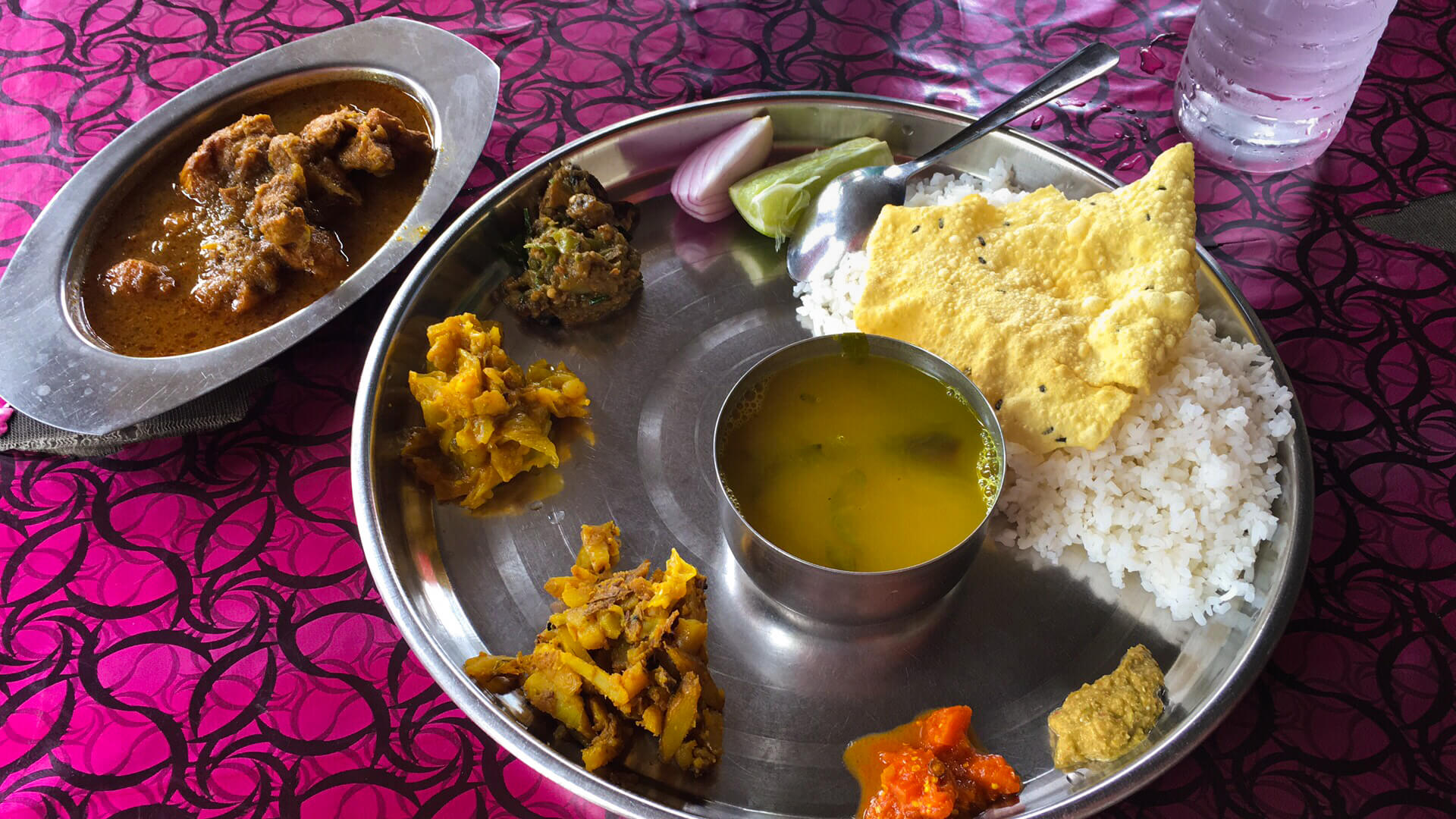
One of the best things about India – even basic food in a pokey little restaurant by a bus station is amazing!
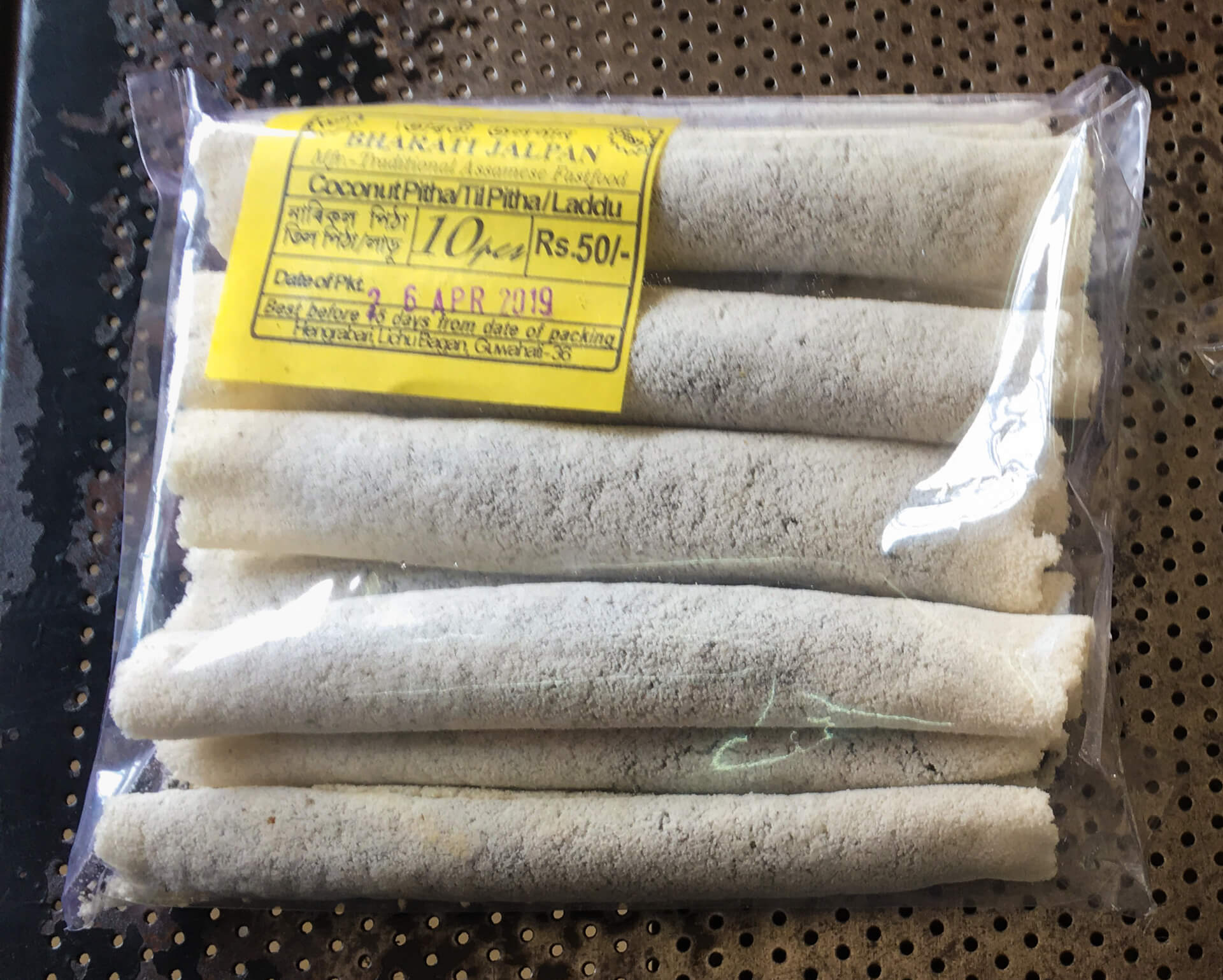
Sesame snacks for the journey.
As I only had eight days, I’d plotted the most straightforward course possible though the seven sisters to the border with Myanmar. This meant two nights in Numaligarh, Assam, which I’d chosen because I found a friendly-seeming Couchsurfing host there, two nights in Kohima, the capital of Nagaland, and 2-3 nights in Manipur, depending on whether I wanted to leave crossing to Myanmar until the very last day of the visa or cross the day before to leave a little margin for error.
Couchsurfing Numaligarh
After an extremely bumpy six hours (even by Indian standards), the bus dropped me on the edge of a road in the dark with no streetlights and no people. Yes, no people, in India! Fortunately, it didn’t last long. I had only stood there for a couple of minutes, trying to send my location to my Couchsurfing host, Rupam, when a 4×4 stopped and a group of Indians asked if I’d like a lift. I accepted, of course, and they asked where I’m staying, but I didn’t know! Numaligarh is quite a small town though and Rupam is obviously quite famous there, as one of the men in the car asked if I was staying with him! It turned out that he lived in a workers’ dormitory just two minutes from where the bus had dropped me off, so they very kindly left me by the side of a roundabout just outside.
Rupam came out to meet me and took me into the dorm, where I met several of his friends. He also told me about the town. The area we were in was the Numaligarh Refinery Township, a new town of about ten thousand people built a few years ago by Numaligarh Refinery Limited, a company that owns a giant oil refinery nearby. The original town of Numaligarh is a few kilometers away. Numaligarh Refinery Township is bustling with well-educated employees of the refinery and companies that serve it, and their families. It’s also right in the middle of the Assamese jungle, which was more than evidenced by the dense green foliage just in front of the dormitory I was staying in.
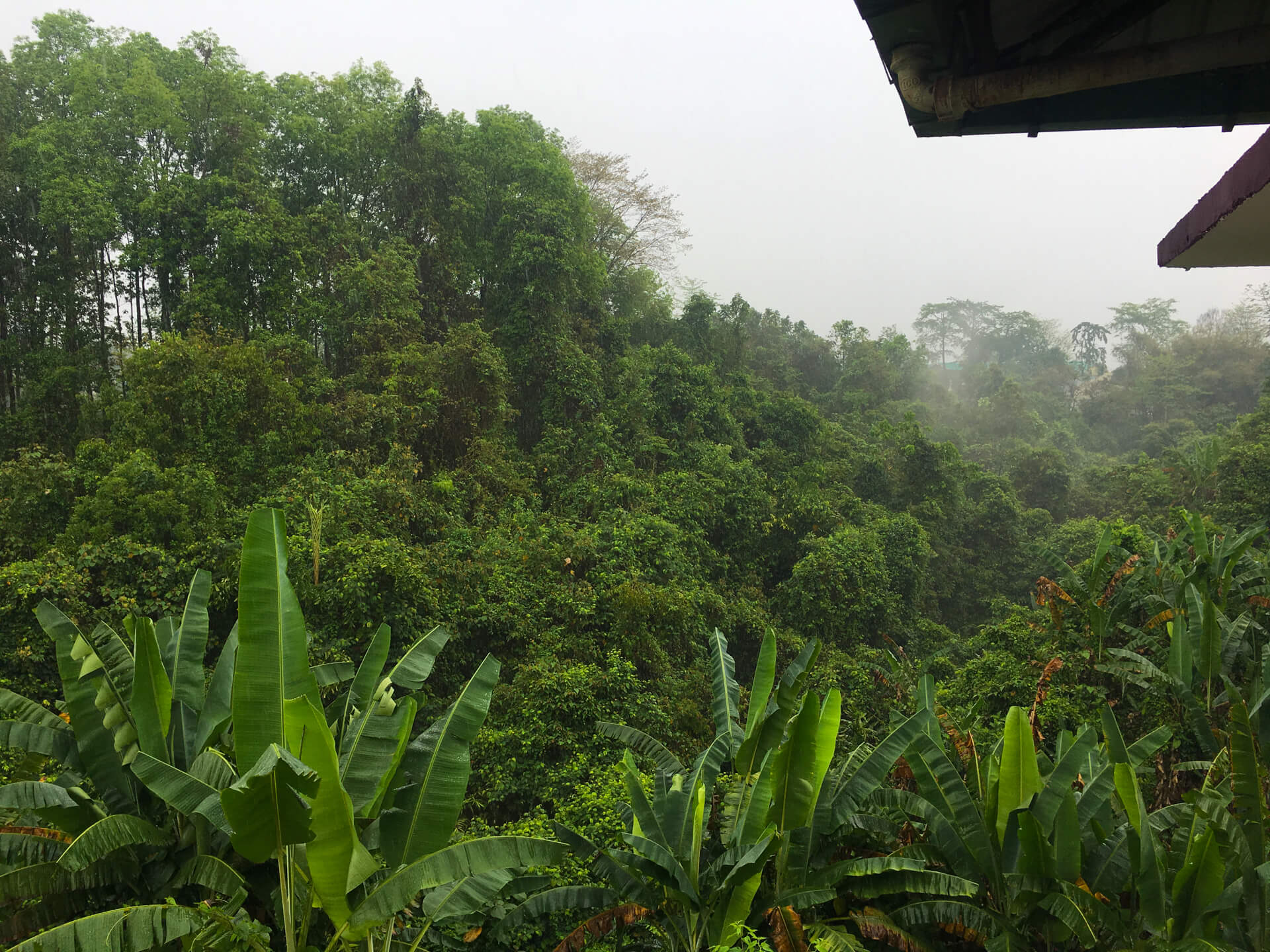
The dormitory where I Couchsurfed was on the edge of the dense Assamese jungle.
In the evening, Rupam had to work, but a friend of his called Bhaskarnil kindly invited me to accompany him to visit his cousin’s family. Their house was on the edge of a nearby tea plantation, where his cousin works. I was shattered from not sleeping all night and the long bus journey during the day, but I wasn’t going to miss an opportunity like this, so of course I accepted.
In the car on the way to the plantation, Bhaskarnil took me on a short tour of the shiny new town, stopping off at a reception centre and a square with a stage set up and for the Assamese Bihu festival, which was in full swing, with traditional Assamese dancing and other performances. The new town is not historic in any way, but it was interesting to get a glimpse of a different, bourgeois side of north-east India. This was the last modern part of India I would see during this trip.
We arrived at Bhaskarnil’s cousin’s house and received a hearty welcome from the whole family, after which his relative’s wife worked in the kitchen while the men gathered in the living room with a bottle of Scotch. Yes, Scotch! And Indian Scotch at that. You can actually buy a 70cl bottle of Scotch in India for about €3 ($3.60). Looking at the ingredients, I discovered that it’s actually a mixture of a small proportion of imported Scotch from Scotland with a much higher percentage of a type of Indian alcohol, the flavour of which is masked by the strong taste of the Scotch. Clever and very popular – I saw it all over the place while I was in India. I was also quite happy that it wasn’t homemade. The international news had been full of reports that over a hundred people had died from drinking poor quality homemade alcohol in the state of Assam only a couple of months earlier.
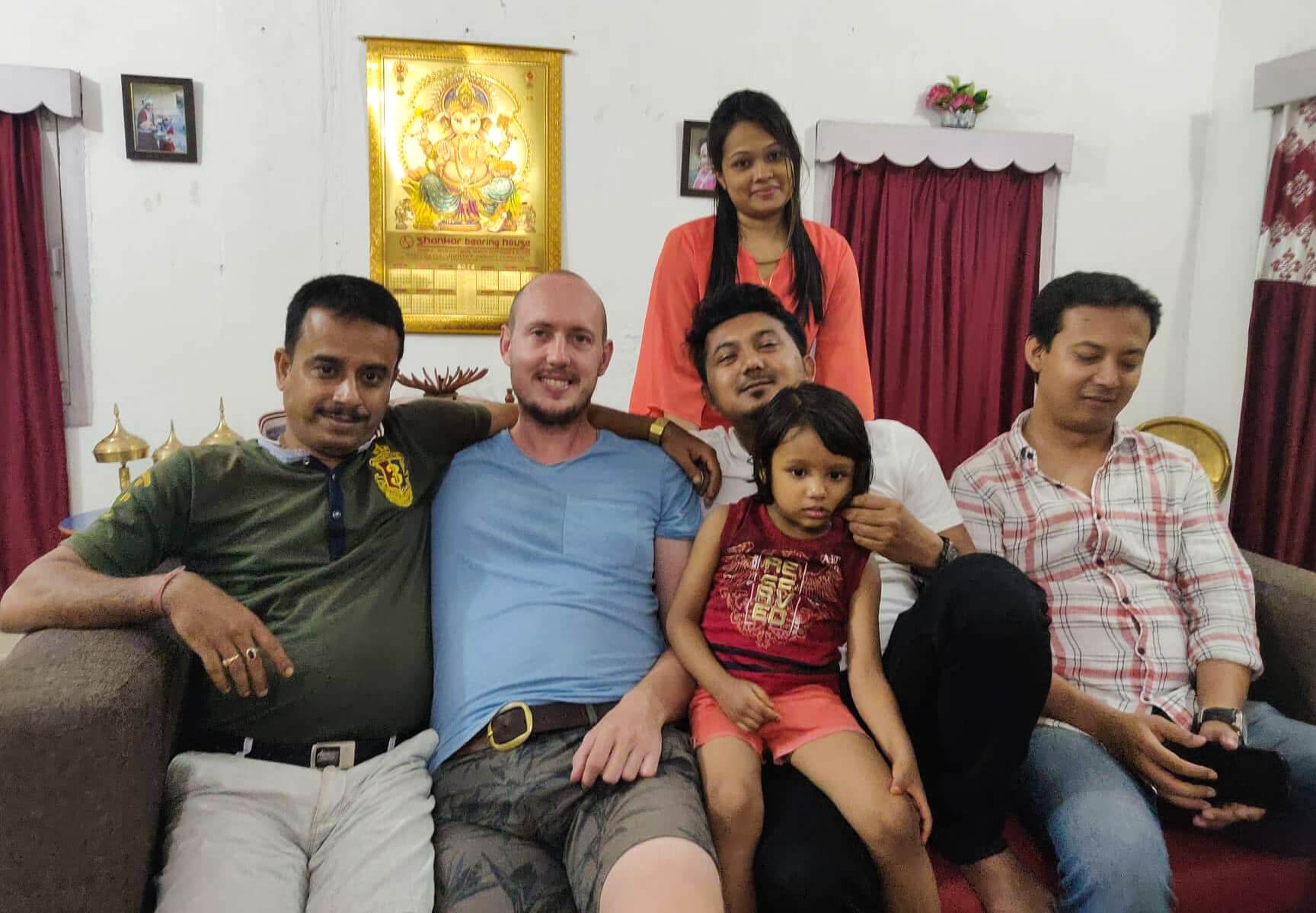
Hanging out with Bhaskarnil’s cousin and family.
We drank and chatted until gone midnight, by which time I was almost falling asleep. The conversation had begun to wane and I was looking forward to going back to the dormitory to the comfy bed that Rupam had prepared for me when suddenly the relative’s wife appeared from the kitchen and announced that it was time for dinner! Yes, at gone midnight! I dragged myself off the sofa and into the dining room. The feast that awaited was enough to make anyone feel less tired. My first home-cooked meal in north-east India was a banquet, but also just the first taste of the amazing hospitality that I would encounter throughout the Seven Sisters. After we had eaten our fill, and Bhaskarnil’s cousin had made sure that I couldn’t eat another thing, it really was time to leave and we went back home to bed.
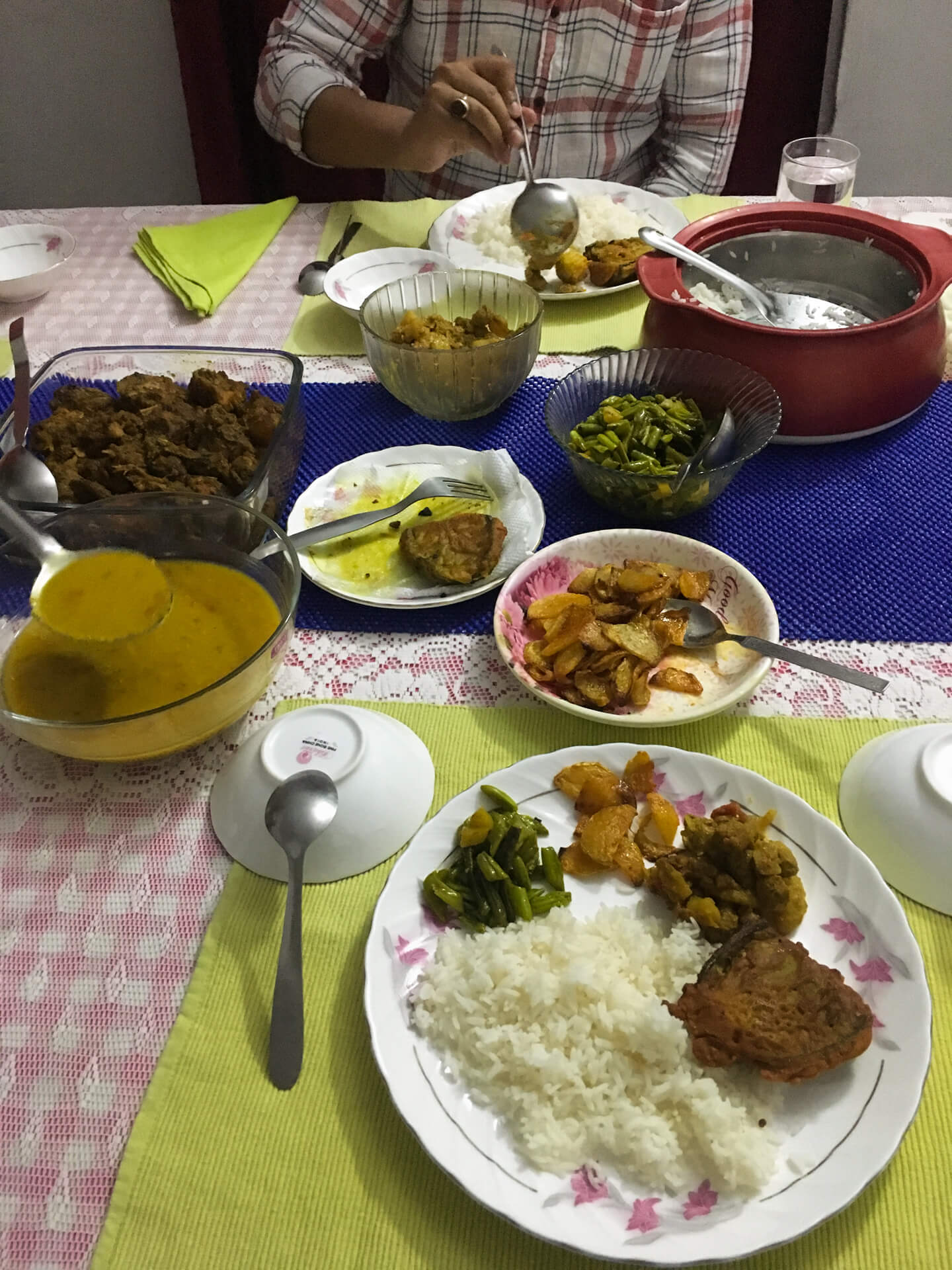
Did I ever mention how much I love India food? And home-cooked is the best! I’m not quite sure what everything was, but it was delicious.
Kaziranga National Park
Like much of the time when I Couchsurf, I hadn’t done much research on what there actually was to see around Numaligarh. My passion is to meet local people, hang out and find out about their lives, and I usually do one or two tourist attractions at the same time. In this case, the main attraction was the Kaziranga National Park, an hour and a half’s drive back towards Guwahati.
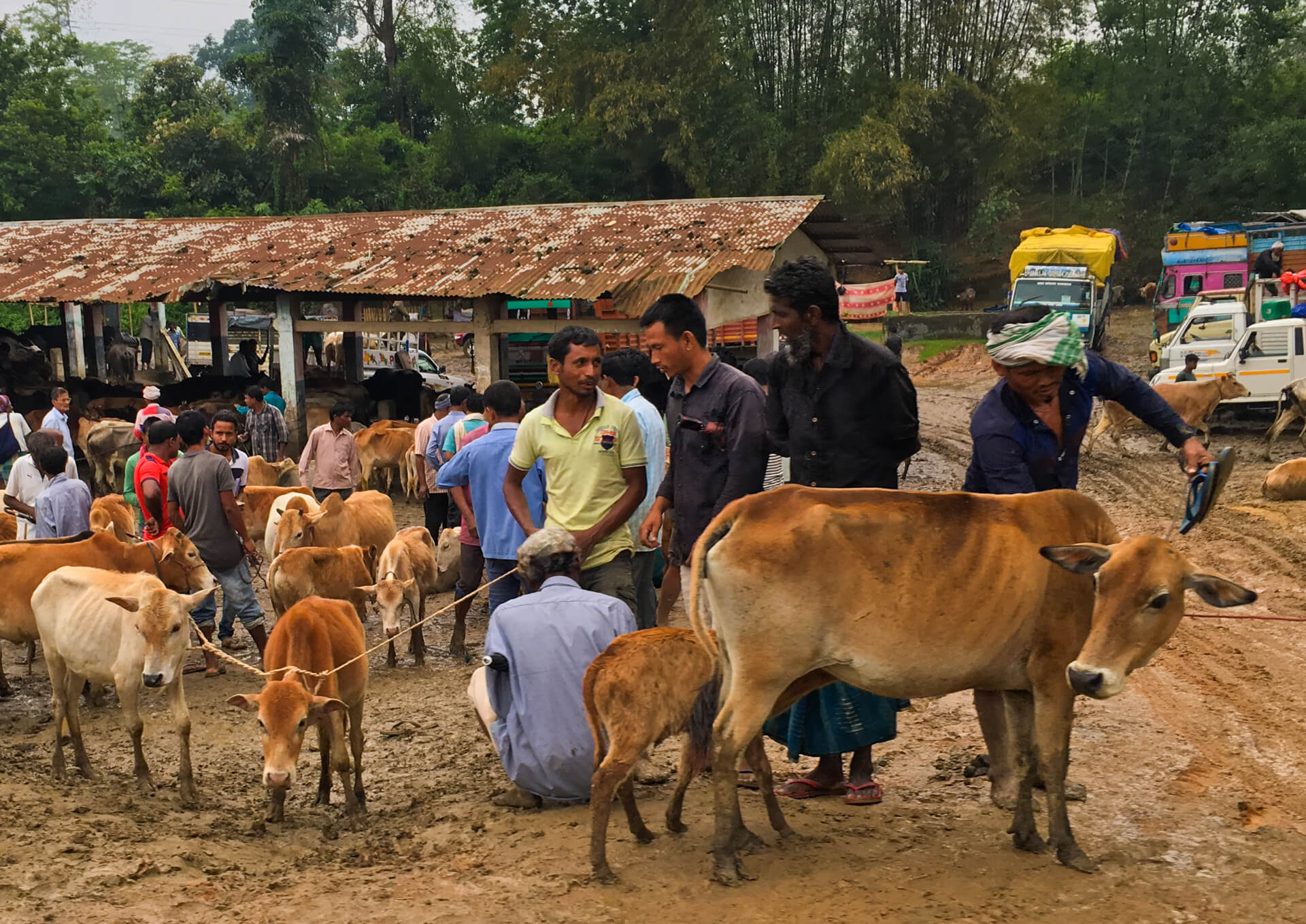
A cattle market on the side of the road on the way to Kaziranga National Park.
I have been on several National Park safaris before, most notably in the Masai Mara in Kenya (an unforgettable experience) and the Yala National Park in Sri Lanka (a totally forgettable experience). The parks in Kenya were teeming with exotic animals, but due to the prevalence of poaching, rhinos are extremely rare. Kaziranga, on the other hand, has a huge population of around two and a half thousand rhinos and they are everywhere. It’s just beautiful. We took a two and a half hour afternoon tour and probably saw about twenty of them during that time, which was well worth the price of 2,900 rupees (€37/$42) that I paid for the park entrance and tour. We also saw a few elephants, which was a bonus.
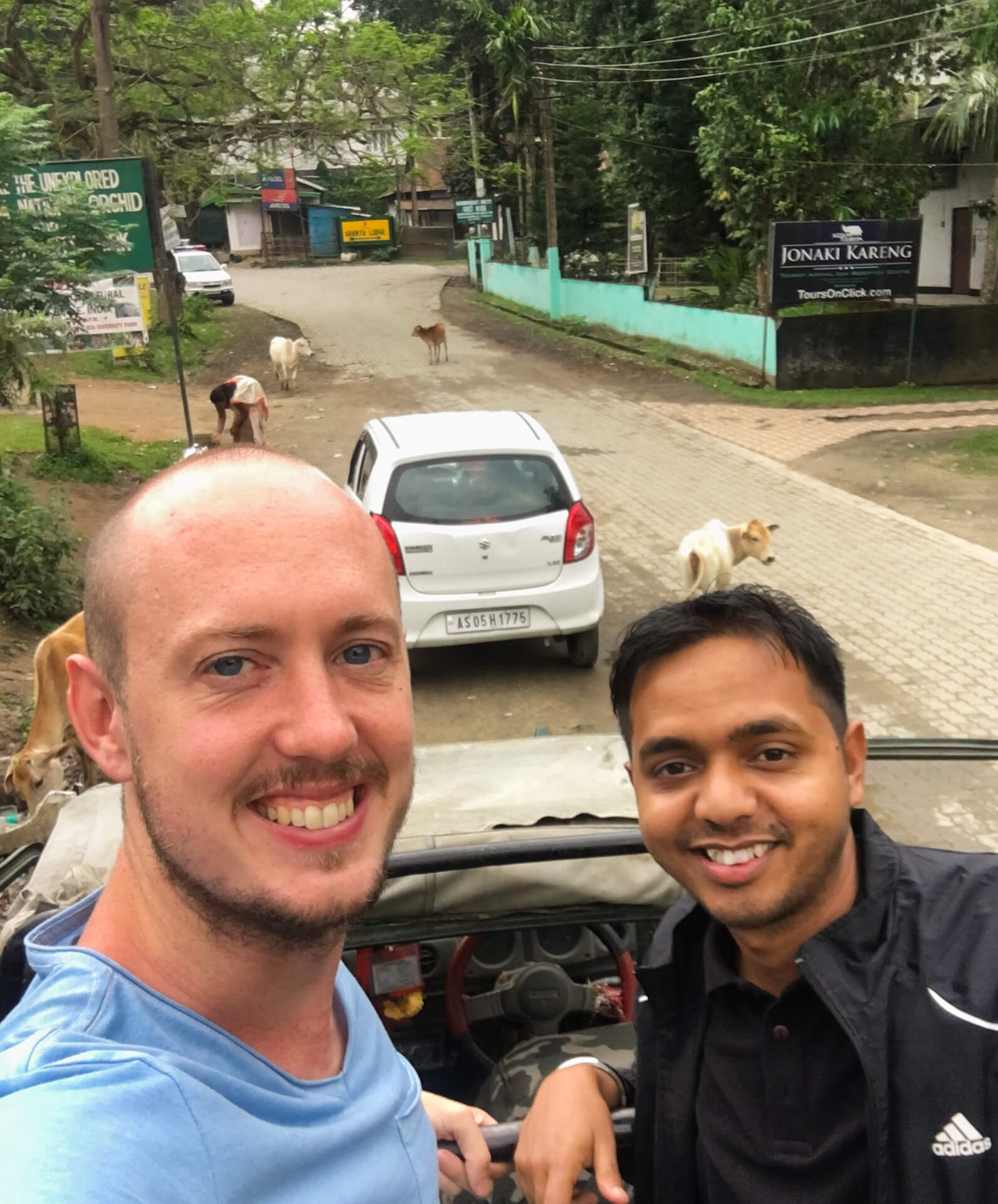
Rupam and I with grins of anticipation as we head towards the park entrance.
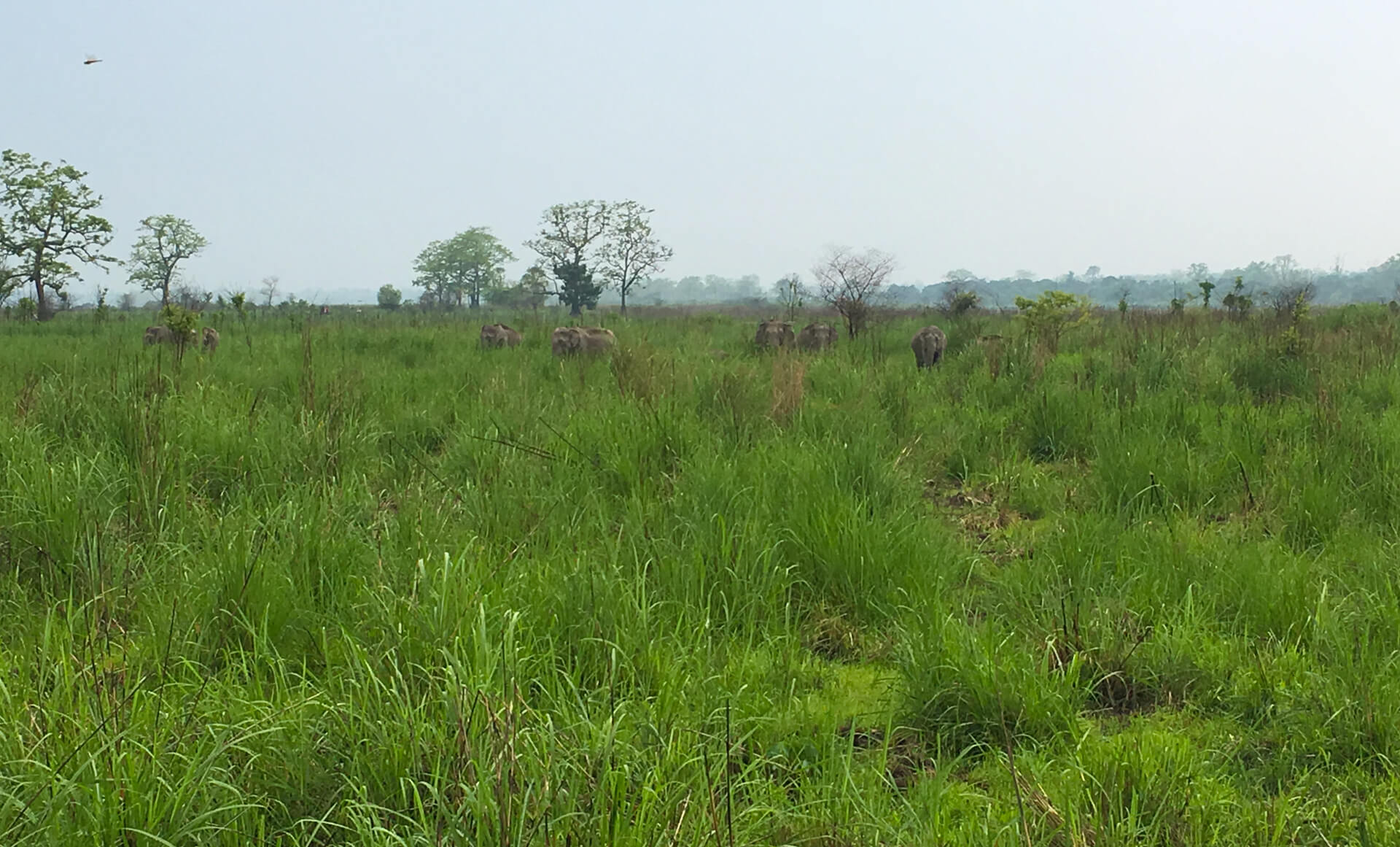
Elephants grazing in the Kaziranga National Park – it’s times like this I wish I had a better camera.
The star attraction at Kaziranga is the Royal Bengal tiger, the national animal of both India and Bangladesh. Even though in the rest of the world they’re known as just plain Bengal tigers, you will never hear a local Assamese say this without the word ‘Royal’ at the start. Apparently this epithet was added because some members of the British royal family used to hunt them and the name has stuck in India. Rupam had warned me before we entered that seeing a Bengal tiger was highly unlikely, especially in March, as the grass is tall. Sure enough, we didn’t see one, but the number and beauty of rhinos more than compensated for the lack of tigers.
We had our own jeep and driver for the tour. The driver’s English was enough to give some explanation of the park, but luckily I had Rupam to interpret whenever communication became tricky. There were quite a few other jeeps driving around the park, mainly carrying domestic Indian tourists, although there were a few other foreigners as well. One thing that did make me laugh was watching some of the domestic tourists with their cameras. They would see a rhino and, ‘snap snap’, take a couple of shots. Then maybe an elephant would appear and again, ‘snap snap’. Then they would notice me in our jeep and, guess what – again, ‘snap snap!’ Foreigners are not common in this part of India and local tourists seemed to consider me just as exotic as any of the animals!
On the way back out of the park, we came across a herd of elephants being fed by park rangers. They are beautiful creatures and I enjoyed being able to get really close to them. This was a new experience for me. Asiatic elephants are quite small and cute compared to the savanna elephants I saw in Kenya, and so relatively safe to get close to.
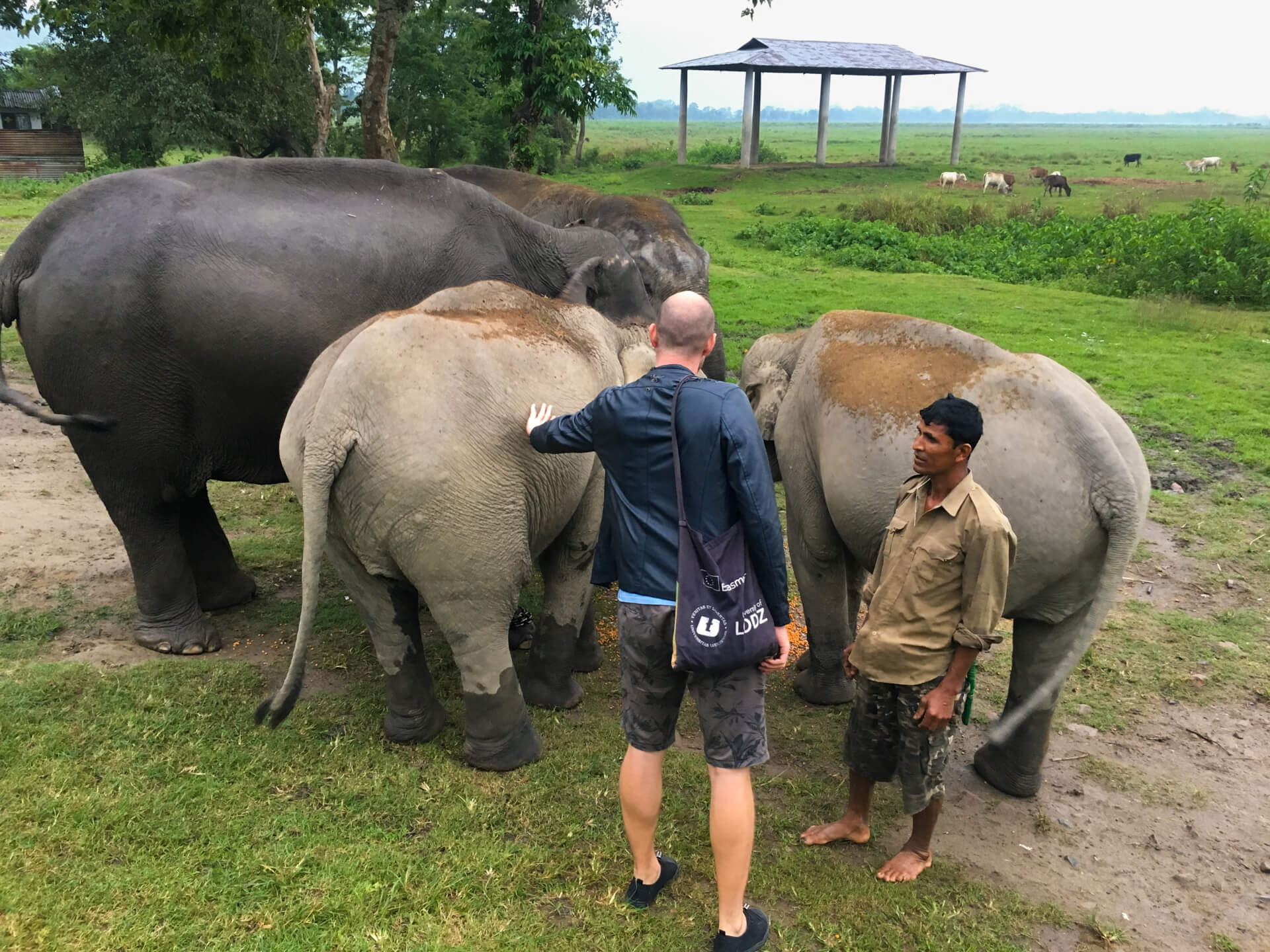
Petting an elephant at feeding time while a ranger watches on.
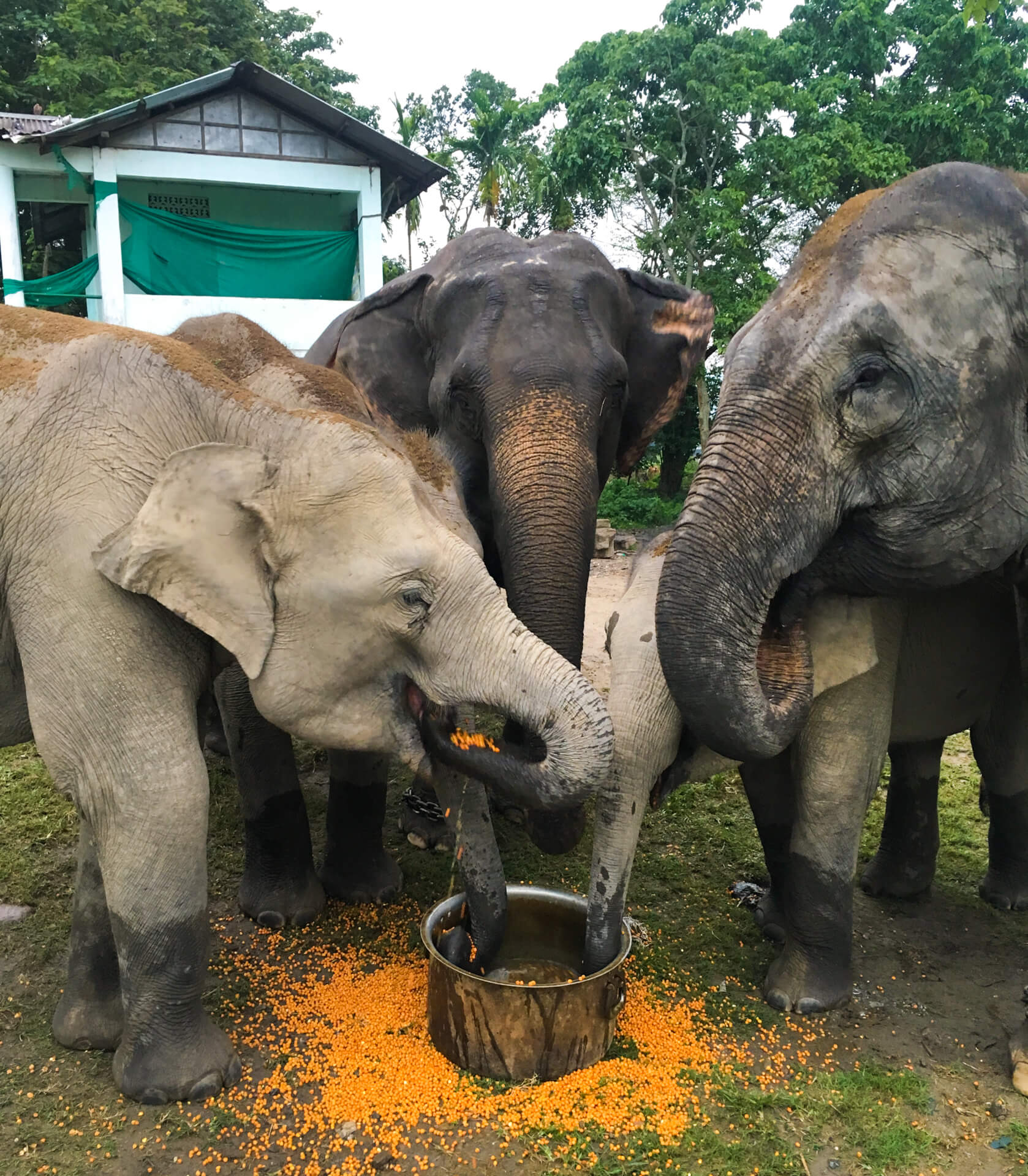
They look happy, but how can you tell?
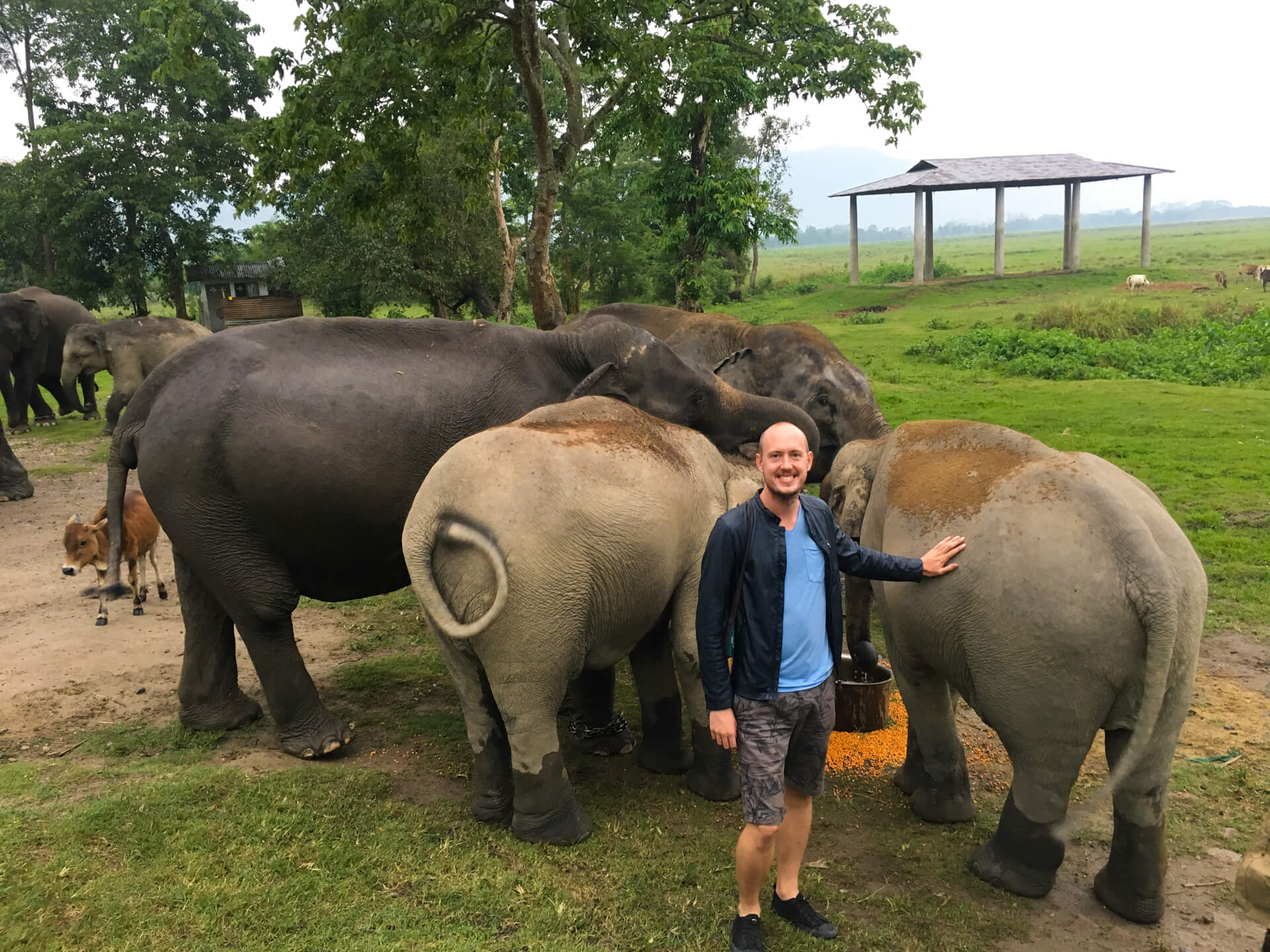
Beautiful creatures.
I’ve always avoided visiting elephant sanctuaries and the like in South East Asia, because there are so many stories of elephants being badly treated and I have heard that riding them is very bad for their health. At Kaziranga, they seemed okay, but of course I couldn’t say for sure from my short visit. However, a bit of Googling reveals that the Kaziranga National Park runs an elephant ‘health camp’ to look after the elephants and also organises elephant rides, so I have mixed feelings.
In the evening, we met up with some friends of Rupam’s for a delicious dinner and some drinks at a nearby restaurant. Afterwards, while driving back to Numaligarh, we stocked up on beers from a bottle shop and then had a small party in Rupam’s dorm. Partway through, we took some time out to visit the Bihu festival and watch some performances, which were taking place on the stage I had seen the night before. They were a mass of swirling colours, as performers danced in their traditional clothing to music both ancient and modern. It was nice to see how the local community had kept their traditions alive despite the influx of workers from other regions of India and the money that the refinery must have brought to the area.
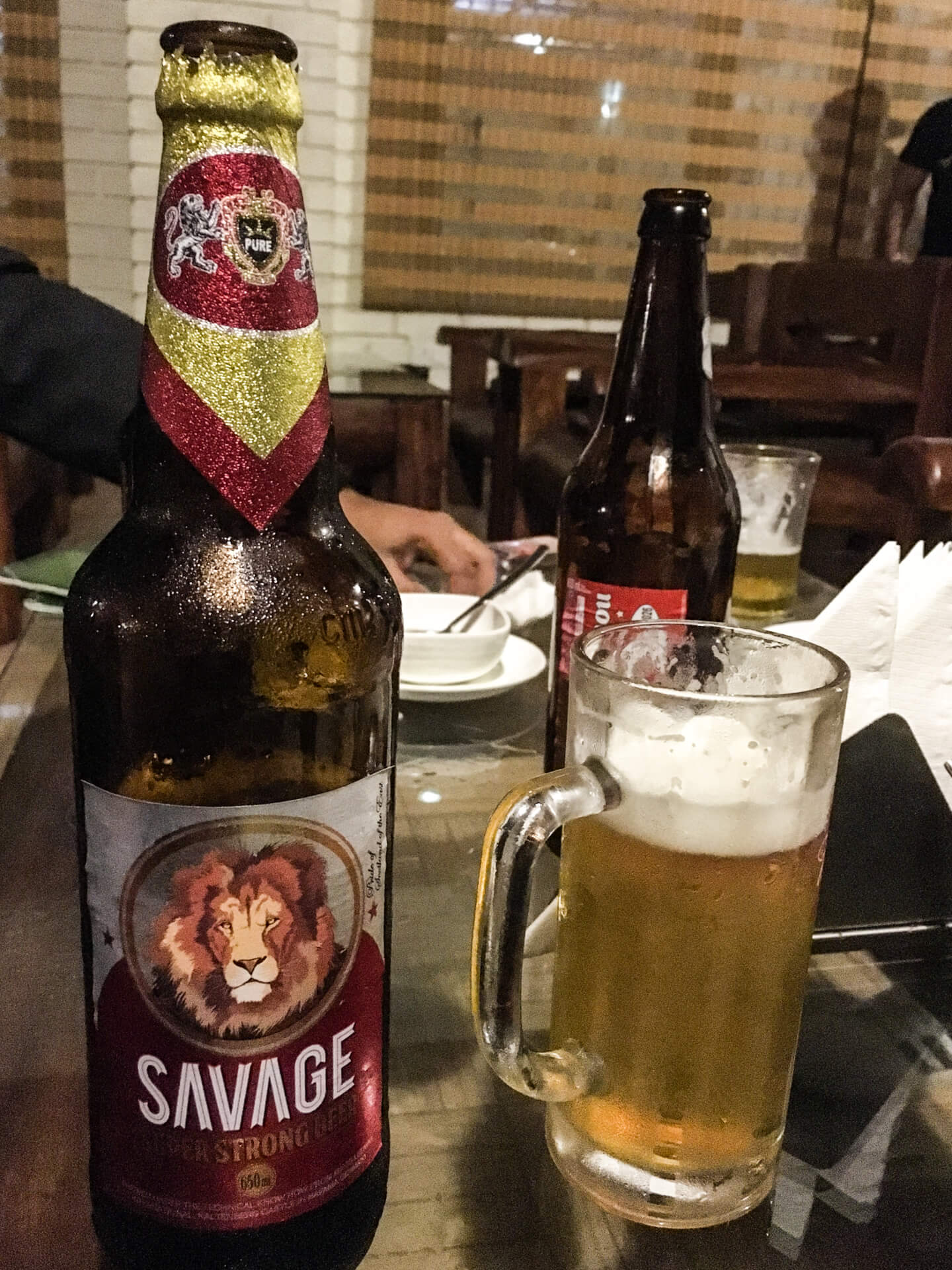
(Almost) local Savage beer, from the neighbouring state of Meghalaya.
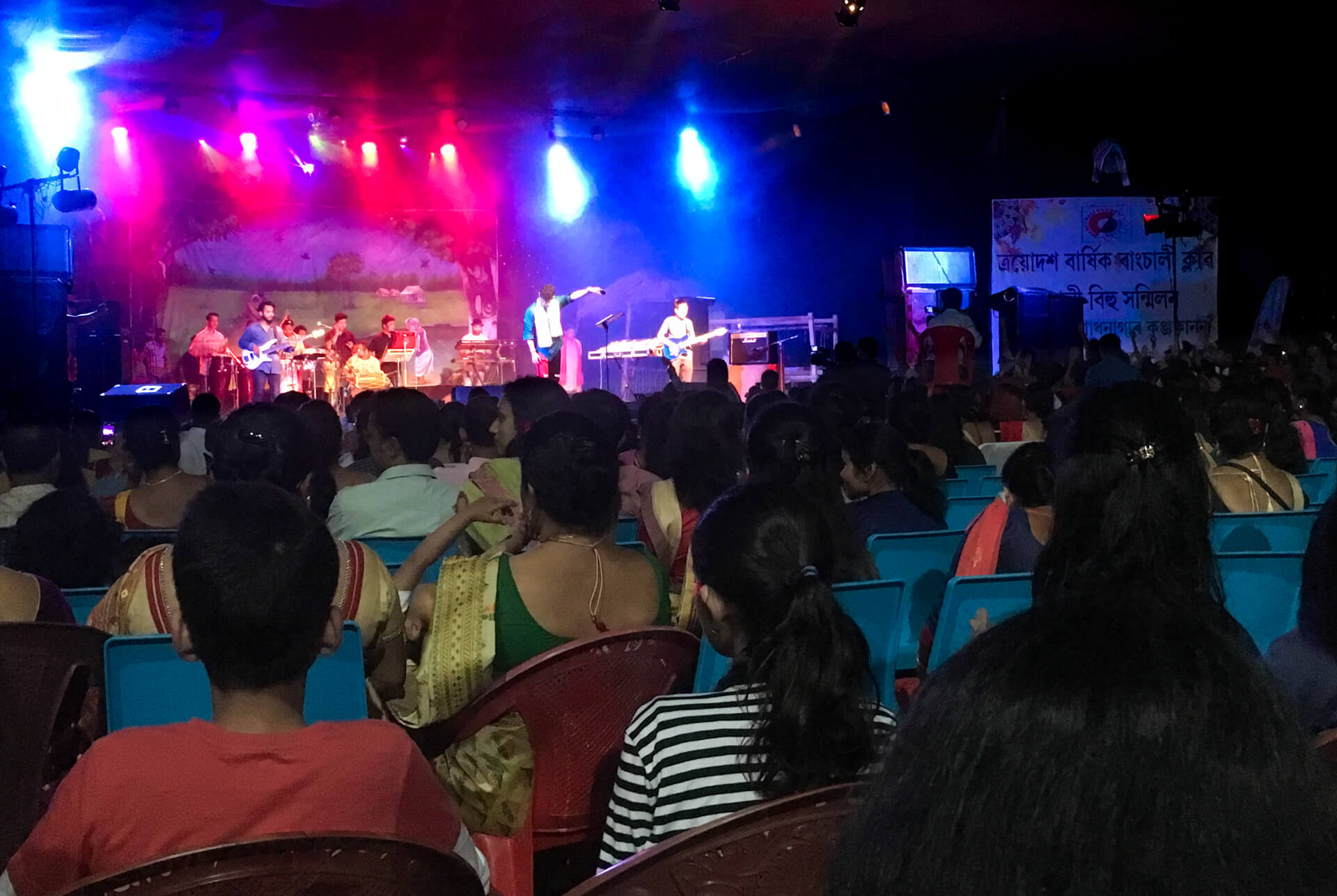
The local Bihu festival performances were very professionally done.
My time in Numaligarh was short, sweet and a great introduction to Assamese hospitality. I didn’t get to do most of the local sightseeing activities because of my limited time, but I did see the key highlight, the Kaziranga National Park, and, more importantly, I experienced first hand why Assames hospitality is famous throughout India. For anyone with a bit more time, I would totally recommend to stay longer in Assam, hang out with the locals, visit some of the local tourist attractions (this region is particularly famous for tea plantations, which are beautiful) and see other parts of the region. With direct flights from Delhi to Guwahati for about €50 ($56), there is really no reason not to escape the crowds of ‘mainland’ India and visit this exotic corner of the subcontinent.
More Adventures in India
India is such an amazing country, I’ve been there three times and still can’t wait to visit again. If you want hear more about it, check out my other articles:
Gandikota: The Grand Cayon of India (another Couchsurfing adventure)
The Belum Caves: India’s Underground Labyrinth
Useful Tips
- The airport shuttle bus costs 90 rupees (€0.99/$1.20) and the public bus to the ISBT is just 10 rupees (€0.11/$0.13).
- A two and a half hour afternoon tour of the Kaziranga National Park costs 2,900 rupees (€37/$42). This price is for a private safari vehicle and driver, regardless of the number of tourists.
- The Bihu festival occurs three times a year, in April, October and January. The April Bihu, which I attended, is called Rongali Bihu and celebrates the spring. The January Bihu is called Bhogali Bihu and celebrates the harvest and the Kati Bihu, in October, is held at a time when crops are not yet ready to be harvested and food is scarce.
- Flights from Delhi to Guwahati are very regular and cheap, starting at about €50 ($56).
- The Myanmar eVisa is valid at the two land border crossings from India.
- The Indian eVisa cannot be used on first entry to cross from Myanmar into India via the land borders. It is only valid for entry at selected airports. However, subsequent entries can be through land borders (which is very convenient for a side trip to Bangladesh or Nepal).
- If you’re travelling by long-distance bus in India, download the redBus app. It was recommended by an Indian friend and made bus journeys so much easier than previously. You can use it to book bus tickets easily with many different bus companies and it accepts foreign credit cards (if only Indian trains could also be booked this way). However, the real advantage is with the GPS tracking. In most cases you can see on a map not only the exact location to board your bus (useful, as many stop at private bus company offices and not the main bus stations), but also the real-time location of the bus itself. The app will inform you of any delays and the expected time of arrival. You can download it from the Android/iPhone app stores.

I’ve always been curious about India. So long that I didn’t finish reading but I’d be the same w the police lol